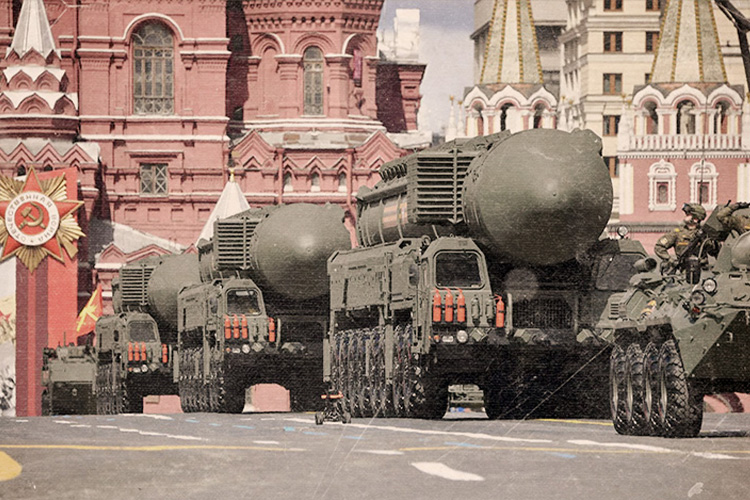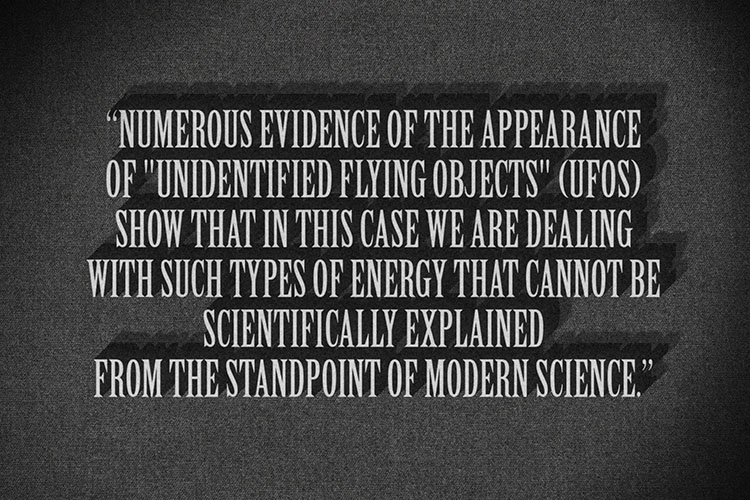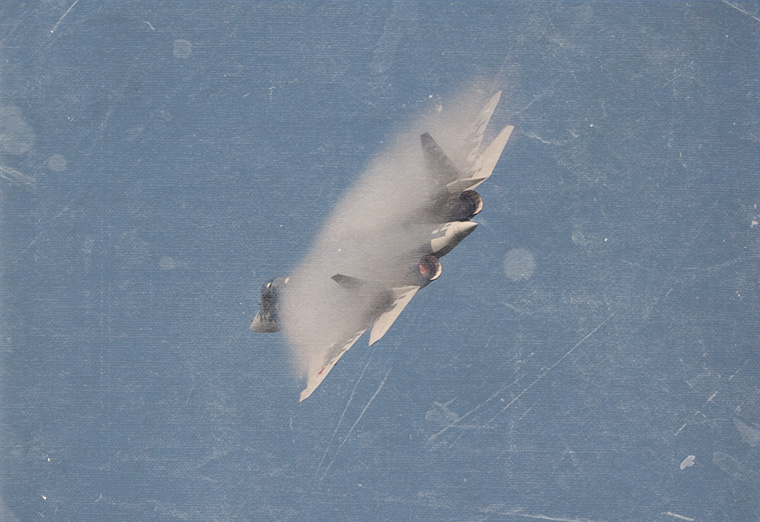The Strange Tale of Russia’s UFO Wonder Weapons Based on “New Physical Principles”
During a ministerial meeting on November 30, defense minister Sergei Shoigu said Russia needed to further develop and deploy advanced, next-generation weapons in its ongoing war with Ukraine.
“It is necessary to continue the modernization and creation of advanced systems with their subsequent use in the course of a special military operation,” said Shoigu.
Shoigu did not elaborate on what new weapons he was referring to or how they might be employed by Russia’s military forces.
However, previous comments by the former Deputy Prime Minister in charge of Russia’s weapons industries, Yury Borisov, may offer some clues on Shoigu’s “advanced systems.”
“The main priorities will be in such areas as the development of high-precision weapons, including hypersonic weapons, the introduction of robotic systems, [and] weapons based on new physical principles,” Borisov told Interfax-AVN, when discussing Moscow’s “State Armaments Program 2024-2033.”
Borisov’s mention of developing “weapons based on new physical principles” will raise more than a few eyebrows.
Perhaps more intriguing is the notion that developing weapons based on the frontiers of physics appears, at least in part, to stem from an oddly matter-of-fact belief by a retired Russian Major General and nuclear weapons expert in the existence of “unidentified flying objects” or UFOs.
Interestingly enough, the former director of science and technology for the entire US Intelligence Community says there could be some merit to this seemingly taboo idea.

The concept of weapons “based on new physical principles” isn’t necessarily unique, and the use of the term dates back over four decades to the Soviet era. Beginning in the mid-1970s, the term was used to describe various exotic military concepts, including psychophysical and genetic weapons.
Following the Soviet Union’s 1991 collapse, discussions on developing weapons based on new physical principles disappeared.
However, ten years into his reign as Russia’s de-facto Czar, Vladimir Putin rekindled the term, evoking it in promises that the Kremlin would soon be using new physics principles to develop all sorts of Wunderwaffe.
In 2012, Putin published an article in Russian-state media asserting that Russia’s long-term military goals included “the creation of weapons based on new physical principles (radiation, geophysical, wave, genetic, psychophysical, etc.).”
“All this will make it possible, along with nuclear weapons, to obtain qualitatively new instruments for achieving political and strategic goals,” Putin wrote. “Such weapons systems will be comparable in results to nuclear weapons, but more ‘acceptable’ politically and militarily.”
Putin’s pledge to develop more “acceptable” wonder weapons might easily be written off as little more than a hyperbolic political promise. A month after the article was published, Putin would win a third term as Russia’s perennial leader. However, shortly after the presidential elections, the Kremlin was still talking about weapons based on new physical principles.
In a cabinet meeting on March 22, former Defense Minister Anatoly Serdyukov told Putin that officials were drawing up plans to create weapons based on new physical principles, including the genetic and psychophysical weapons Putin had previously mentioned. Serdyukov promised Putin the development of these sinister but vague new weapons would be finished by 2020.
Considering there has been no evidence of any super weapons in Russia’s 2022 war with Ukraine, it doesn’t appear that Serdyukov was able to come through on his promise. Though in fairness, a few months after the March meeting, Serdyukov was sacked by Putin and replaced by current Defense Minister Sergei Shoigu.
The concept of developing weapons using novel physics, however, didn’t follow Serdyukov out of the Kremlin. Putin, the MoD, and Russian state media all continued to periodically discuss “weapons based on new physical principles.”
In an article published by the Kremlin-media outlet Rossiyskaya Gazeta, military analyst Sergei Ptichkin said that these new physics wonder weapons weren’t only possible but had been in development since the 1980s.
“The USSR surpassed the USA by leaps and bounds in developing weapons based on new physical principles,” wrote Ptichkin.
According to Ptichkin, Soviet scientists had developed new forms of radiation that could stop enemy tanks, “bio-robotic” super soldiers, and “psychotronic generators” that could brainwash people at a distance.
In October 2017, Russian Major General Oleg Kislov told the state media outlet Tass that “military equipment based on new physical principles” was already being tested at the Kapustin Yar testing range in the southern Astrakhan Region.
Notwithstanding these claims, and again considering the Russian military’s performance in Ukraine, this renewed talk of weapons based on new physical principles appears to be little more than propaganda. Essentially, fantasies designed to make the Russian public feel more secure about its place in the world’s military hierarchy.
However, perhaps the most intriguing part isn’t whether or not Russia has developed or is trying to develop “bio-robotic” super soldiers. Instead, it is where this revived concept of weapons based on new physical principles appears to stem from.

When mentioning the desire to develop weapons based on new physical principles, Putin has, at times, seemingly quoted verbatim portions of a 2009 paper titled Weapons of the XXI Century, written by a retired Russian Major General, nuclear weapons expert, and leading researcher at the Russian Center for International Security, Vladimir Belous.
Published in the Russian language journal International Affairs, Belous describes several new types of future weapons based on qualitatively new physics principles.
“In the coming decades, it is possible to expect the emergence of new types of weapons of mass destruction, the scientific and technical ideas of which are already known today, and some of them are already being developed,” wrote Belous.
Most, if not all, of the examples mentioned by Belous, including genetic and psychotronic weapons, have at some point been mentioned by Putin or Russia’s MoD as the types of weapons based on new physical principles they aim to develop.
Ironically, Belous, an anti-nuclear weapons advocate and one of 57 retired generals and admirals from militaries across the globe who signed a 1996 declaration calling for the abolition of nuclear weapons, appears to have written the paper as a warning. Not in the encouragement of developing these new super-weapons.
Some of Belous’ predictions of future weapons flirt with the fringe. In the section on “Weather Weapons,” Belous mentions the US Department of Defense’s former “High-Frequency Active Auroral Research Program” (HAARP), an ionospheric research program located in rural Alaska.
HAARP has been called the “the Moby Dick of conspiracy theories,” with proponents believing the facility’s high-frequency antenna array can be used to control and weaponize weather.
Scientists have long maintained that conspiracy advocates are ignorant of what the large Ionospheric Research Instrument (IRI) at HAARP is capable of and of the bounds of natural science. Not to mention that since 2015, HAARP has been solely operated by the University of Alaska Fairbanks, not the DoD.
To his credit, Belous only mentions that some claim that directed beams of high-frequency radio waves from HAARP’s antenna array could be used to form plasma and cause instability in the ionosphere, creating devastating weather effects.
In the bulk of the “Weather Weapons” section, Belous discusses other little-known but factual, former top-secret programs exploring weather modification, including Project Skyfire, Project Prime Argus, and Project Stormfury.
Alarmingly, some of Belous’over decade-old predictions on future weapons have already proven spot-on.
In the section on “Information Weapons,” Belous correctly assesses how the insertion of carefully crafted propaganda and “fake news,” coupled with the rapid proliferation of mass media and the internet, can be used in information operations at the operational-tactical level.
“The dosed presentation of ideologically and psychologically processed provocative material, the skillful alternation of truthful (“credit of trust”) and false information, the skillful montage of details of various real and fictional explosive situations can turn into a powerful means of psychological offensive,” wrote Belous.
“It can be especially effective against a country in which there is social tension, interethnic, religious or class conflicts. Carefully selected information, falling on such favorable ground, can in a short time cause panic, riots, pogroms, and destabilize the political situation in the country.”
In another instance, Belous mentions the potential for using deep water thermonuclear weapons to create a destructive radioactive tsunami capable of consuming an enemy’s coastal regions.
This is the exact purpose of Russia’s nuclear “mega torpedo,” codenamed “Status-6″ or “Poseidon,” which Moscow first revealed in 2015, six years after Weapons of the XXI Century was published.
In yet another section, Belous mentions that Russia has made “significant progress” in recent years in the development of radio-frequency (RF) and electromagnetic pulse (EMP) weapons.
Specifically, Belous says that new RF-EMP weapons have been successfully developed at the Moscow Radiotechnical Institute of the Russian Academy of Sciences under the codenames “Ranets-E,” “Rosa-E,” and “Mobile Microwave Protection System Project (MMPS).”
Effects of these RF-EMF devices, and others described in the “Acoustic Weapons” section, when used on the human body, sound hauntingly similar to those described by sufferers of the mysterious Havana Syndrome.
Given this, the Kremlin’s desire for “weapons based on new physical principles” suddenly begins to feel more ominous than bombastic propaganda.
However, above everything else, the most intriguing and eyebrow-raising thing mentioned in Weapons of the XXI Century comes in the preamble justification for the potential of weaponizing yet-to-be-discovered physics.
Nonchalantly and matter-of-factly, Belous says “numerous evidence” proving the existence of “unidentified flying objects” or UFOs demonstrate there is more out there than can currently be explained by modern science.
“There is no doubt that as the natural sciences develop and fundamental discoveries appear, fundamentally new ideas will appear in them, on the basis of which new types of weapons can be created,” Belous wrote.
Numerous evidence of the appearance of “unidentified flying objects” (UFOs) show that in this case, we are dealing with such types of energy that cannot be scientifically explained from the standpoint of modern science.”
Belous says that as scientific and technological progress accelerates, some government power could potentially unmask, harness, and weaponize this novel and unexplained energy displayed by UFOs.
“At the same time, it is not excluded that as scientific and technological progress accelerates, mankind can gradually master these types of energy, which, in turn, can be used for military purposes.”
Without elaborating further, Belous describes the existence of UFOs as if it was gravity – a fundamental force of nature we know is real but don’t fully understand – before launching into the weapons potential from the new physics principles used by this mysterious unidentified aerial phenomena.

Unfortunately, three weeks after President Putin invoked some of the themes of his 2009 paper, Vladimir Semenovich Belous passed away on March 9, 2012. He was 85 years old at the time of his death.
And while the idea of UFOs may be taboo, it’s hard to call Belous a quack.
Born in 1927, Belous served over 40 years in the Soviet military’s artillery and strategic missile forces, retiring at the rank of Major General.

During his tenure, he held many prominent positions, including Director of the Center for International and Strategic Studies, Head of the Military Policy Sector of the Center for Scientific Research of the Committee of Scientists for Global Security, head of the educational department of the Dzerzhinsky Special Weapons Military Academy, professor at the Russian Academy of Military Sciences, and leading scientific officer of the World Economy and International Relations Institute of the Russian Academy of Sciences.
After retirement, Belous was viewed as a renowned Russian nuclear and strategic weapons expert. In the late 1990s, Belous prepared policy papers on the massive gap between Russian and Western high-precision weaponry for then-president Boris Yeltsin.
Belous’ papers on Russian strategic nuclear policy have also been repeatedly cited in published works by the US Army War College and the Defence Academy of the United Kingdom.
After Putin’s rise in 2000, Belous largely faded from the public eye. Occasionally writing research papers, but no longer holding prominent positions in Russia’s defense sector. It is likely that many of Belous’ beliefs, such as advocating for the reduction of Russian nuclear weapons, were at odds with the ascending Putin.
Missing from his impressive biography is any evidence of Belous having a particular interest in UFOs or even any involvement in some of the known fringe “paranormal” programs of the late Soviet Union.
Why Belous so casually cited UFOs as evidence in Weapons of the XXI Century remains a lingering mystery.
Looking at his background, which appears to be that of a prominent Russian military officer who held various high-level positions in the strategic military sciences and the development of advanced weapons, one can’t help pondering: “Man! This is the type of person who would know if there was ‘numerous evidence’ conclusively proving that UFOs represented examples of unknown physics principles.”
In the last few years, the subject of UFOs or “unidentified aerial phenomena” has suddenly emerged as a legitimate topic of discussion.
US lawmakers, The Pentagon, NASA, and US Intelligence Community have all publicly discussed UAP and the need to thoroughly investigate these mysterious incidents. Even China announced last year that it had formed its own new unidentified aerial phenomena task force to investigate an uptick in mysterious sightings.
However, determining how Moscow views the subject domestically and in the increased foreign interest is murky. Mainly because the Kremlin and Russian media do not discuss the topic of UFOs whatsoever.
In August 2020, Russian cosmonaut Ivan Vagner posted a clip on Twitter of five mysterious objects appearing to move near earth orbit in a time-lapse video taken while aboard the ISS. Within hours of posting the video, numerous Russian-state media outlets responded with various experts offering several most-likely prosaic explanations.
A month later, Vagner posted another video on Twitter showing another similar sighting of multiple objects. “The mystery seems to be solved!” wrote Vagner. “These are satellites, more and more of them every time. Soon, the sky will be full of spacecraft!”
Indeed, the objects in both of Vagner’s videos resemble SpaceX’s Starlink satellite constellations.
As global interest in UFOs has grown, aside from Vagner’s apparent misidentification, Russian media has wholly refrained from jumping into the fray. At most, some Russian outlets will aggregate Western news stories on the US government’s UFO pursuits without adding their own thoughts.
With a topic rife with conspiracy theories and axioms of government mistrust, it is somewhat remarkable that Russia’s state security apparatus hasn’t seized upon the revived Western interest in UFOs to seed seditious themes. At a minimum, that the Kremlin hasn’t even poked fun at America’s UFO interest is bizarre.
And yet, Moscow has maintained radio silence.
Aside, of course, from encouraging the development of new wonder weapons, which evidently, are possible because of UFOs.

Agreeing to speak under the condition of anonymity, a long-time senior US Intelligence Community member told The Debrief that trying to decipher the Kremlin’s interest in UFOs or UAP is nuanced.
“So, like the US and others, Russia has and does, from time to time, encounter airborne targets they can’t identify or explain. What those are range from mostly normal stuff that happens to look weird for one reason or another… to…I don’t know,” the intelligence official said. “But Russia also has a history of using UFOs for intelligence purposes and information operations.”
According to the official, in the late 1970s and 1980s, Soviet intelligence services believed that persons interested in paranormal topics like psychics, ghosts, or UFOs were “mentally weak” and highly susceptible to malign influence.
“The KGB and Chekist had formal programs targeting persons who held security clearances or worked around classified programs, who also had an interest in UFOs, psychics, etc. We know this for a fact,” the official explained.
“Honestly, a lot of the UFO lore likely emerged from these battles between Soviet intelligence and US counterintelligence that were going on in the shadows in the 1980s.”
The Debrief reached out to the Central Intelligence Agency (CIA) to see if records were available for what sounds like a fascinating tale of espionage, counter-espionage, and UFOs. In response, the CIA said it could “neither confirm nor deny” that any records of such activities existed.
The agency’s official history, The CIA’s Role in the Study of UFOs, 1947-90, does appear to offer a subtle confirmation of these KGB vs. CIA UFO spy games.
“Agency analysts from the Life Science Division of OSI and OSWR officially devoted a small amount of their time to issues relating to UFOs,” the report notes. “These included counterintelligence concerns that the Soviets and the KGB were using US citizens and UFO groups to obtain information on sensitive US weapons development programs (such as the Stealth aircraft), the vulnerability of the US air-defense network to penetration by foreign missiles mimicking UFOs, and evidence of Soviet advanced technology associated with UFO sightings.”
According to the intelligence official, Russia’s unwillingness to discuss UFOs, especially the United States’ sudden interest, likely has some to do with its own history of using the subject as an intelligence tool. “The term ‘UFO’ was banned at one point in the Soviet Union. They used it as a trap, so they probably assume it’s a trap now.”
The intelligence official was unsure why Vladimir Belous cited UFOs in his paper on future weapons. However, they said it was unlikely that this specific–and seemingly incredible–detail was intentionally-planted misinformation.
“Probably not disinfo. It’s a pretty obscure, Russian-language-only paper,” the official The Debrief spoke with said. “Now, why he said it is another story.”
Former senior US Intelligence Community official Dr. Eric Haseltine told The Debrief it isn’t entirely crazy to consider whether UFO sightings might potentially offer evidence of yet-discovered physics principles.

From 2002 to 2005, Haseltine served as the Director of Research for the National Security Agency (NSA), and in 2005, he was named the first director for science and technology for the Office of the Director of National Intelligence (ODNI).
“I think there might be something to it,” Haseltine said about the recent US military encounters with unidentified aerial phenomena and the idea that new physics principles might be involved.
“To me, the main attribute of UAP sightings is the speed,” Haseltine said, “the incredible acceleration. Going to basic [physics] principles, if you’ve got this incredible acceleration, either you have very big “F” or very small ‘M.’”
The “F” and “M,” mentioned by Haseltine, refer to the fundamental physics equation that acceleration (A) is equal to the net force of an object (F) divided by that object’s mass (M). The principle derives from Sir Issac Newton’s second law of motion.
Given that some of the UAP sightings by witnesses describe objects as large as a fighter jet – for example, the “Tic Tac” shaped object seen by the US Navy’s Nimitz Carrier Group in 2004- if composed of known materials these objects would likely weigh roughly 15 to 20 tons or 30,000 to 60,000 pounds. Simply put, an object that large would possess fairly significant mass.
“Physicists at the State University of New York at Albany in 2019 calculated that 1100 Billion Watts of energy, more than 100 times that produced daily in the US, would be needed to move objects that heavy that fast,” Haseltine wrote in an article for Psychology Today.
“Which quickly takes us into the realm of completely unknown physics.”
“It looks like it’s very, very, very small ‘M’ that we’re dealing with. Very small mass when it comes to the equation for mass times acceleration,” Haseltine explained.
“One explanation is that the UAPs have essentially no mass and thus no aerodynamic surfaces that would create sonic booms because they are not manufactured physical objects, but an exotic (yet known) form of matter called free-air plasmas.”
Haseltine, who served as the chief science and technology officer for the entire US Intelligence Community, said that currently, the technology capable of moving light-weight objects or forming plasmas that look and behave like reported UAPs doesn’t exist. At least not in the US arsenal.
“Someone else theoretically could have developed such technology and might have deployed it for reasons we can only guess,” added Haseltine, who, before his career in intelligence, was the Director of Engineering at Hughes Aircraft, followed by Executive Vice President of research and development for Walt Disney Imagineering.
Haseltine says it’s not totally out of the realm of possibility that all the UAP discussions in the past few years are part of some elaborate deception, similar to what reportedly happened between the KGB and CIA during the 1980s.
“You always have a cover story, and you have incidents like the Glomar Explorer. So you could argue there’s a gray area there,” said Haseltine.
The “Glomar Explorer” was the name of the deep-sea drillship owned by Howard Hughes and used by the CIA to recover the nuclear-armed Soviet submarine K-129, which sank in the Pacific Ocean, roughly 1,560 miles northwest of Hawaii in 1968.
Under the codename “Project Azorian,” the CIA crafted an elaborate cover story to conceal its recovery of K-129. The plan involved having the influential business mogul Hughes tell the media that the Glomar Explorer was being used to extract manganese nodules from the ocean floor for marine geology.
When news of Project Azorian came to light in 1975, the CIA refused to “confirm or deny” the reports. The response not only became a pop culture cliche but also led to what is now known as the “Glomar response,” used to respond to Freedom of Information Act requests for still classified records, which may or may not exist. This is the same response received by The Debrief when seeking records concerning counterintelligence operations involving UFOs during the 1980s.
And though it can’t be entirely ruled out, for legal reasons, Haseltine said it is unlikely that all the current UFO hubbub is really some elaborate disinformation campaign.
“I’ve been personally involved in many conflicts with lawyers over exactly this type of thing,” said Haseltine. “When we were trying to get some high-value targets from Al-Qaeda, we came up with all sorts of ideas to get them to reveal themselves. Some of them involve deception in the public sphere. But the lawyers just wouldn’t allow it.”
“So when you’re talking about willful disinformation, to mislead the public for political purposes. I tend to believe that the lawyers are going to look unfavorably on that.”
Haseltine also agreed that, unlike with the Glomar Explorer, in the past several years, you have had principal U.S. officials, like the Director of National Intelligence, Under Secretaries of Defense, and lawmakers publicly discussing unidentified aerial phenomena.
Rather than elaborate disinformation conspiracy or cover-up, Haseltine said when it comes to UAP, the most likely explanation is the US government doesn’t know what’s going on.
“I was in a position to know things like that. And I never found out anything,” said Haseltine. “I was what is called a ‘Super User,’ and I got read into all kinds of stuff because they have to have some kind of counselor body for oversight on all the super black stuff. To make sure that there weren’t abuses because that happens in the black world. No one’s looking at what you’re doing. It’s not even in the congressional budget. And it was stuff that wasn’t in the congressional budget that I looked at and I never saw anything like that.”
“So if I had to wager, I’d say they just don’t know.”
Ultimately, Haseltine says that more rigorous study is needed to determine what UAP is or isn’t.
“In intelligence, we would do pattern analysis. Look at what common threads there were. And you look at what’s going on in the environment, when it’s going on, and in relation to what? And then you look at behavior, and you try to see patterns,” said Haseltine.
“There’s all sorts of questions you’d want to ask about consistency. If you took all of the data that was available and seemed credible and you tried to look for patterns. What would you see? You have to try and construct experiments that would confirm or falsify a different hypothesis. That’s that kind of thing that I suppose is going on in the Pentagon right now.”
“When you hear the beat of hoofs, do not assume they’re a zebra. It might be a zebra, or it might not. I think the main point is that there are some, out there, but physically possible explanations.”
The idea of creating UFO wonder weapons “based on new physical principles” seemingly sounds ridiculous. However, Haseltine says it’s likely a mistake to outright dismiss Moscow’s technological and militaristic aspirations as just propaganda.
“The Russians, in particular, are way ahead of us in certain directed energy programs,” said Haseltine. “They are very resourceful, and I don’t think we should count them out in any way, shape, or form. Not that people are.”
Haseltine points out there are plenty of reasons that some of the exotic, RF-EMF, and acoustic weapons mentioned in Belous’ paper sound precisely like the type of things that could account for the rash of anomalous health effects commonly referred to as the “Havana Syndrome.”
“I worry that what’s going on is real and say the Russians are doing it for the same reason they do the Colonial Pipeline, and for the same reason, they buzz our airplanes and harass them,” Haseltine shared his thoughts on the Havana Syndrome incidents. “There’s a whole under-surface campaign going on. And I don’t know what our side is doing, but it’s definitely war. It’s a gray war going on.”
“I view the Havana syndrome as just one arrow in the quiver that the Russians use to influence our thinking.”
Of course, as Haseltine also points out, producing the health effects observed in Havana Syndrome victims doesn’t require discovering any new physics principles. “I have pictures of stuff they’re selling on Russian websites, that would do the trick. They’re selling them on the open market.”
Haseltine said he worries that exploring Russia’s attempts at developing “weapons based on new physical principles” or Havana Syndrome incidents are taboo subjects, highly discouraged by senior leadership in the Intelligence Community.
“I think what’s happening inside the Agency is that there are some people who were working on it [Havana Syndrome] that were convinced that it was real and that it was probably the Russians,” said Haseltine. “But then there was the official party line from the State Department and leadership and said, ‘No, there’s nothing here to see.’ And certain officers considered it career-limiting to pursue it further. I don’t know this for a fact, but it worries me.”
Ironically, this is the same sentiment shared by several US defense and intelligence officials when describing the consequences of investigating unidentified aerial phenomena.
Obviously, just because Belous’ paper on future weapons appears to be some of the impetus behind the Kremlin’s calls for “weapons based on new physical principles,” this doesn’t mean that Putin or his inner circle likewise see UFOs as being viable proof of yet to be discovered energy.
Of course, the alternative, no matter how remote, could be a terrifying proposition given what Russia has already developed, or possibly developing, that doesn’t require the discovery of new physics principles.
Perhaps the best way to view Russia’s bizarre claims of wanting UFO wonder weapons based on new physics principles is with healthy skepticism while subtly remembering something once shared by astronomer and former advisor to the Air Force’s official study of UFOs Project Blue Book, the late Northwest University astronomer J. Allen Hynek.
“I wake up every day,” Hynek once said, “worried I’m going to see that the Soviets have solved the UFO mystery first.”
Tim McMillan is a retired law enforcement executive, investigative reporter and co-founder of The Debrief. His writing typically focuses on defense, national security, the Intelligence Community and topics related to psychology. You can follow Tim on Twitter: @LtTimMcMillan. Tim can be reached by email: tim@thedebrief.org or through encrypted email: LtTimMcMillan@protonmail.com



